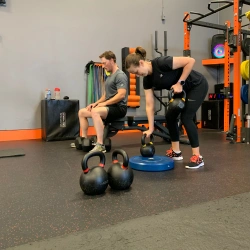

One of the biggest questions people have when they start training is whether they are doing enough to see progress or if they are pushing so hard that they are actually hurting their results. The truth is there is a sweet spot when it comes to training volume, and exercise science gives us some useful concepts to help figure it out. These are Maintenance Volume, Minimum Effective Volume, and Maximum Recoverable Volume.
Maintenance Volume is the lowest amount of training you need to simply hold on to your current fitness. From research we know this is surprisingly little. For most trained individuals as few as one or two hard sets per muscle group per week can be enough to maintain strength and size. That is why even during busy weeks or travel, shorter workouts can still be effective. You will not make progress, but you will not lose ground either.
Minimum Effective Volume is the next step up. It is the lowest amount of work that actually produces gains in strength, endurance, or muscle growth. Anything below this threshold may feel productive, but it will not drive adaptation. Think of MEV as the point where training starts to move the needle forward. Anything just one notch above maintenance but still below MEV is essentially wasted effort. You have done more work than you needed to maintain, but not enough to stimulate real progress.
On the other end we have Maximum Recoverable Volume. This is the highest amount of training your body can handle before recovery starts to break down. Once you push beyond this point you accumulate so much fatigue that it negatively affects the rest of your week. Not only does progress stall, but your risk of injury or burnout goes up. In other words going past MRV is not extra credit. It is counterproductive.
So how do you know where you land between MEV and MRV? A helpful tool is a simple questionnaire that you can use after each workout.
1. How hard was the workout?
2. How much of a pump did you feel?
3. How sore are you the next day?
Each question is scored on a scale from zero to two. Zero means the workout wasn't very hard and you had no pump or weren't sore at all, one means the workout was moderately tough and you had a slight pump or you felt your muscles afterwards. Finally two means the workout was difficult and you were really pumped up and felt sore into the following day. When you add your total score together afterwards, a total score of 0-2 means you were under MEV, while a score of 3-4 means you're at MEV, while a 5-6 likely means you've achieved MRV.
With that in mind, its also important to recognize that these are not fixed numbers. They are moving targets. Your MEV changes as you adapt. Your MRV can shift with lifestyle stress, sleep, and nutrition. And your maintenance level will always be lower than you think. That is why in our small group personal training at AIM Athletic we adjust training volume week to week, not just to your fitness level but to your current circumstances. Our hockey athletes for example can handle far more work during the off season than they can during a heavy game schedule. Members recovering from an injury may need to sit closer to maintenance or MEV so we can build capacity without tipping into overtraining.
The fitter you become the closer your MEV gets to your MRV. Eventually the volume needed to make change starts to flirt with overtraining. This is why high level bodybuilders will spend entire workouts hammering one muscle group and then not touch it again for days. They need that much focused volume to make progress but also that much recovery time to balance it out.
At the end of the day what matters most is not the specific model you use to measure intensity. What matters most is that you are doing the work consistently and with purpose. Training is about finding that balance point where you are working hard enough to grow but not so hard that recovery cannot keep up. That is the art of coaching and what we intend to bring into every session at AIM Athletic whether it is small group training, personal training, active rehab, or training for hockey.
You've got the info now it's time to take AIM,